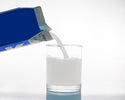
What is The Healthiest Milk For Teenagers?
, by Dr. Jeff Pearl, MD, 2 min reading time

, by Dr. Jeff Pearl, MD, 2 min reading time

“Drink your milk or else you won’t get dessert or cannot leave the table.” Sound familiar? We have all grown up hearing those words and likely say them to our own children now. Obviously as infants and babies, milk traditionally has been a mainstay of nutrition in Western Countries such as the United States. Remember the quote from Napoleon Dynamite? “If you are drinking 2% because you think you are fat, you could totally be drinking whole milk”. So what are the nutritional facts for milk and what is the healthiest milk for my teen? First off, it is worth the few extra cents to buy organic. The nutritional facts for a six ounce cup of milk (and let’s be honest who drinks only 6 ounces?) are as follows:
| Per 6 ounces | Calories | Fat (gms) | Carbs | Protein |
|---|---|---|---|---|
| Whole Milk | 146 | 7.9 | 11 | 7.9 |
| 2% Milk | 122 | 4.8 | 11.5 | 8 |
| 1% Milk | 102 | 2.4 | 12.1 | 8.2 |
| Skim Milk | 86 | .4 | 11.9 | 8.35 |
Using the above nutritional facts, the first question is how much milk does your teen drink daily? If it is one cup then it really does not matter which they choose, although I would avoid whole milk. If they are drinking several cups or a few glasses a day then the choice of milk can significantly impact their nutritional profile.
In general, a good balance for carbs, fat and protein calories is around 40% for carbs, 30% for protein and fat. (Remember though that fat has more than twice as many calories per gram as does protein or carbs per gram). 1% milk, and even 2% milk fit fairy well with this caloric breakdown. If one is trying to limit fat intake, than certainly non-fat milk will be a decent source of protein without the added calories. Of course if your teen is an athlete, then some extra carbs and fat are okay as long as they are still getting enough protein. If you teens are like mine, eating high carb and high fat food is not a problem for them. Getting enough protein can be. Milk can help, and in general 1% or 2% should be fine for most teens.
For those who are lactose intolerant, soy milk or almond milk are great alternatives. Regular soy milk is fairly close to 2% milk and light soy milk is very close to 1% milk. Both have slightly less protein than milk. Excessive soy intake can result in higher estrogen levels which can be an issue in some teen boys. Almond milk, which tastes great on cereal, is very low in carbs, low in fat and low in calories, but is not a very good source of protein. Here’s to your health and DRINK YOUR MILK, or else!